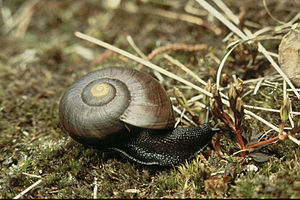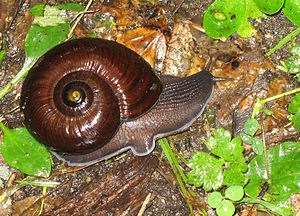
Paryphanta is a genus of land snails in the family Rhytididae. Species from New Zealand are known commonly as kauri snails. They are closely related and similar to snails in the genus Powelliphanta, which was formerly included within Paryphanta.

Rhytididae is a taxonomic family of medium-sized predatory air-breathing land snails, carnivorous terrestrial pulmonate gastropod molluscs in the superfamily Rhytidoidea.
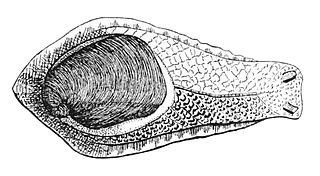
Schizoglossa, common name the Paua slugs, is a genus of medium-sized to large predatory, air-breathing, land slugs, carnivorous terrestrial pulmonate gastropod molluscs in the family Rhytididae. They are currently classified by the New Zealand Department of Conservation as Nationally Vulnerable.

Wainuia is a genus of air-breathing predatory land snails, terrestrial pulmonate gastropod molluscs in the family Rhytididae. Species in this genus occur in New Zealand.
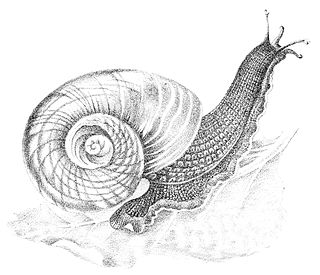
Paryphanta busbyi is a species of large predatory land snail, a terrestrial pulmonate gastropod mollusk in the family Rhytididae.
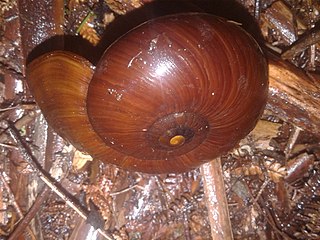
Powelliphanta superba is a species of large, carnivorous land snail in the family Rhytididae, which is endemic to the South Island of New Zealand. Five subspecies are recognised, all of which are classified by the New Zealand Department of Conservation as being Nationally Endangered.

Powelliphanta augusta or the Mount Augustus snail, previously provisionally known as Powelliphanta "Augustus", is a species of large, carnivorous land snail, a terrestrial pulmonate gastropod mollusc in the family Rhytididae. Naturally occurring only on Mount Augustus near Westport on New Zealand's South Island, their entire habitat was destroyed by coal mining. The world population was taken into captivity, in theory until their habitat was restored and they could be released. The mining company concerned went bankrupt and habitat restoration has been unsuccessful, so the species' future is uncertain.

Powelliphanta rossiana, known as Ross' land snail, is a species of large, carnivorous land snail, a terrestrial pulmonate gastropod mollusc in the family Rhytididae. This species is endemic to the South Island of New Zealand. Subspecies include:
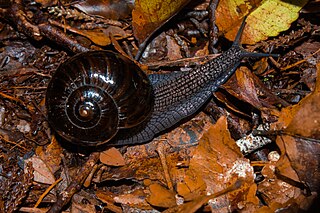
Powelliphanta patrickensis is a species of large, carnivorous land snail, a terrestrial pulmonate gastropod mollusc in the family Rhytididae. This species is endemic to the South Island of New Zealand. Formerly, it was considered as a subspecies of Powelliphanta rossiana.

Powelliphanta gilliesi, one of the "amber snails", is a species of large, carnivorous land snail, a terrestrial pulmonate gastropod mollusc in the family Rhytididae.

Powelliphanta hochstetteri, known as one of the amber snails, is a species of large, carnivorous land snail, a terrestrial pulmonate gastropod mollusc in the family Rhytididae.
Powelliphanta hochstetteri anatokiensis, known as one of the amber snails, is a subspecies of large, carnivorous land snail, a terrestrial pulmonate gastropod mollusc in the family Rhytididae. It is found in New Zealand.

Powelliphanta hochstetteri bicolor, known as one of the amber snails, is a subspecies of large, carnivorous land snail, a terrestrial pulmonate gastropod mollusc in the family Rhytididae.
Powelliphanta hochstetteri consobrina, known as one of the amber snails, is a subspecies of large, carnivorous land snail, a terrestrial pulmonate gastropod mollusc in the family Rhytididae.
Powelliphanta hochstetteri obscura, known as one of the amber snails, is a subspecies of large, carnivorous land snail, a terrestrial pulmonate gastropod mollusc in the family Rhytididae.
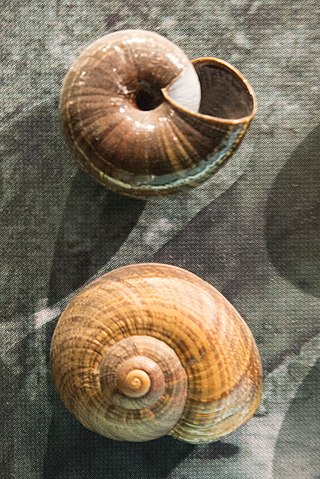
Powelliphanta traversi, known as Travers' land snail, is a species of large, carnivorous land snail, a terrestrial pulmonate gastropod mollusc in the family Rhytididae. This species is endemic to the North Island of New Zealand between Wellington and Lake Waikaremoana.

Powelliphanta lignaria, known as one of the amber snails, is a species of large, carnivorous land snail, a terrestrial pulmonate gastropod mollusc in the family Rhytididae. The eggs of P. lignaria are oval and seldom constant in dimensions 10 × 8.25, 9 × 7.75, 9 × 8, 8.75 × 7.75 mm.
Powelliphanta rossiana, subspecies "Fox", known as one of the amber snails, is an as yet unnamed subspecies of large, carnivorous land snail, a terrestrial pulmonate gastropod mollusc in the family Rhytididae.
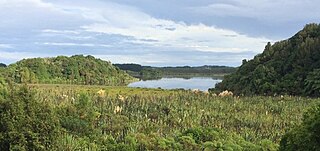
Lake Papaitonga is located in the Horowhenua, an area of the southern Manawatū-Whanganui region in New Zealand's North Island. Part of the Papaitonga Scenic Reserve, a 135 ha area of forest and wetland, it is the only remaining lake bordered by undisturbed native forest in the Horowhenua region, and contains two populations of endangered native land snails. The traditional home of the Muaūpoko people, the lake was the scene of their massacre and defeat by invading chief Te Rauparaha. The naturalist Walter Buller later managed to purchase Papaitonga and its environs for his country home, which led to its forest being preserved and it eventually becoming a scenic reserve.


